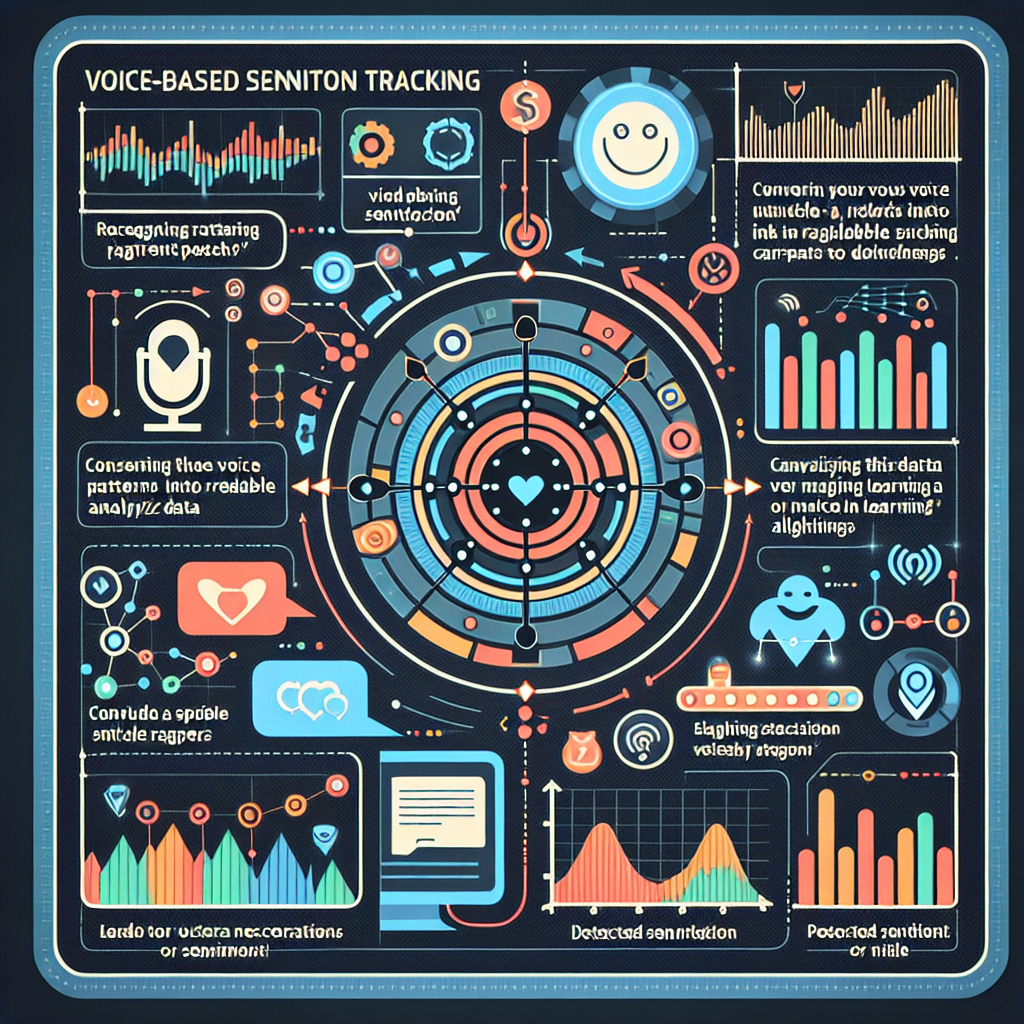
In today's digital world, the importance of voice-based sentiment tracking has massively grown. This cutting-edge technology connects your brand directly to its consumer's mindset, enabling businesses to obtain real-time customer feedback. Rather than relying on traditional methods of manual analysis and speculation, it provides authentic and immediate insights into how customers perceive our products and services.

The process of voice-based sentiment tracking begins by extracting valuable data from customer conversations across numerous communication channels. Next, this data, structured or unstructured, is analyzed using advanced speech-analytics software, which employs powerful algorithms to understand the emotion, tone, and context behind the spoken words. Any feelings of happiness, frustration, or indifference towards the brand are consequently detected, enabling you to instantaneously respond to the customer's concerns and improve customer relations in real-time.
More than a simple customer feedback tool, voice-based sentiment tracking is a critical marketing instrument that allows businesses to make informed decisions about their products or services. By measuring the customer sentiment at every interaction point, companies can detect any inconsistencies in their brand image and can accordingly alter their business strategies to appeal better to their target audience.
As we delve deeper into an era characterized by fast-paced digital transformation, having a finger on the customer's pulse is not just an option; it's a necessity. Companies that leverage voice-based sentiment tracking technology will undeniably find themselves at an advantageous position in this increasingly competitive marketplace.
Voice-based sentiment tracking is a remarkable technology that empowers companies to monitor brand perception using voice inputs from various sources. This involves three main tech areas: Speech Recognition, Natural Language Processing (NLP), and Sentiment Analysis algorithms.
Firstly, speech recognition, also known as Automatic Speech Recognition (ASR), is the tech that transforms spoken language into written text. Modern applications of this technology provide high accuracy and can recognize voices in many languages and accents.
Then comes Natural Language Processing. The textual data obtained from ASR is then processed by NLP, an interdisciplinary scientific field that combines linguistics, computer science, and artificial intelligence. Thus, it understands the contextual semantics, syntactic structure, and pragmatic meaning of the language used.
Finally, the processed natural language data undergoes sentiment analysis, or opinion mining, which is a sub-field of NLP. The sentiment analysis algorithms assess textual data to ascertain emotional tone, attitude, and feelings. This stage involves detecting polarity (positive, negative, or neutral) and emotion (joy, anger, etc.) in the mentioned brand or topic.
These three consecutive stages of voice-based sentiment tracking enable a nuanced understanding of customer sentiment towards a brand. By analyzing this collected sentiment data, companies can respond to positive feedback, address the concerns highlighted by negative commentary, and overall, steer their brand perception in desired ways.
In today's hyper-competitive markets, understanding customer sentiment is crucial for brands' survival and growth. Voice-based sentiment tracking is an advanced technology that offers businesses the ability to gain enhanced customer insights, receive immediate feedback, and improve customer service. By assessing tone, emotion, and context of voice and speech, businesses can gain a deeper understanding of their customers' feelings and opinions towards their brand.

Toward this end, voice-based sentiment analysis provides real-time insights into customers' attitudes and opinions. Real-time sentiment tracking enables businesses to make data-driven decisions quickly that directly impact their bottom line. For instance, if sentiment analysis reveals customer dissatisfaction over a newly launched product or service, brands can intervene immediately, identify the root cause of dissatisfaction, and take corrective action. Thus, real-time sentiment analysis arms businesses with the ability to remedy negative situations, mitigate potential brand damage, and reinforce positive brand perception.
Another notable benefit of voice-based sentiment tracking is the enhancement of customer service quality. Insights obtained from voice-based sentiment tracking can be used to inform and improve customer service training methods, demonstrating the tone and language that resonate best with customers. Consequently, this leads to more personalised customer interactions, increased customer satisfaction, and ultimately, brand loyalty.
Lastly, by monitoring brand perception through voice-based sentiment tracking, businesses can better understand and respond to market trends, anticipate shifts in consumer behaviour, and stay ahead in their respective industries. Adapting swiftly and efficiently to these changes is essential for competitive advantage and longstanding customer relevance.
In conclusion, the strategic importance of voice-based sentiment tracking in monitoring brand perception cannot be overstated. Its potential to transform customer insights and responsiveness indeed makes it an invaluable instrument in any brand's marketing toolkit.
In recent years, various companies, regardless of industry or size, have made significant strides in using voice-based sentiment tracking to monitor brand perception. A careful examination of case studies reveals a great deal about the importance of these advancements.
One key player in financial services that comes to mind is JPMorgan Chase. Voice-based sentiment tracking allowed the firm to effectively gauge consumer reaction to a new online banking service. Relevant feedback, derived from numerous phone interactions with customer service, enabled the business to modify its service to meet customer needs. This directly contributed to a significant increase in customer satisfaction and solidified their brand's reputation.
In the hotel industry, Hilton Hotels utilized voice-based sentiment tracking to monitor customer feedback regarding its premium service offerings. By analyzing the tones and underlying emotions in customer calls, the hotel chain gained valuable insights about guests' general sentiment regarding their service, leading to improvements tailored to create a more positive brand perception.
Another standout example is from the automotive industry. Tesla Inc. leveraged voice-based sentiment tracking to gauge customer reactions to a newly released vehicle model. By parsing sentiment data from phone calls to service centers, they were able to detect and solve issues faster, which not only improved product quality but also boosted the brand's perception of swift and effective customer service.
These examples only scratch the surface of what's possible with voice-based sentiment tracking. As technology evolves, businesses in all sectors will be armed with even more tools to monitor and lift their brand perception, leading to increased customer satisfaction and, ultimately, long-term success.
For brands continuously seeking ways to identify and understand customer sentiment, the advent of voice-based sentiment tracking is a game-changer. By leveraging voice recognition, natural language processing, and artificial intelligence, businesses can dig deeper into the voice nuances of customers, offering insights beyond text.Harnessing the power of voice technology not only defies boundaries but also revolutionizes brand perception monitoring.

Getting started with voice sentiment analysis in your organization necessitates a systematic approach. First, choosing the correct voice sentiment analysis tool is pertinent to the success of your efforts. Look for platforms that offer comprehensive analytics, real-time updates, and multilingual support. Check for compatibility with your current systems to ensure seamless integration.
Next, training your team to harness the tool effectively is crucial. Most of these platforms come with a learning curve, and equipping your staff with the right knowledge substantially influences the output. From understanding how to operate the software to deciphering the gathered data, each aspect requires proficiency.
Data management is another critical aspect of implementing voice sentiment analysis. Regular audits of voice data, filtering irrelevant content, and identifying patterns or trends are tasks that require diligence. Always remember, the more orderly your data, the more accurate your sentiment analysis will be.
Finally, it is worth noting that voice-based sentiment tracking requires an investment in resources and time. With the right support and practices, businesses can leverage this technology to achieve breakthroughs in understanding their customers. Imagine having the ability to know how your customers feel about your brand simply by listening to the tone of their voice - it is reinventing user experience and brand perception tracking in striking ways.
Voice-based sentiment tracking is quickly emerging as a game-changer in the world of brand monitoring. By harnessing the power of artificial intelligence (AI) and machine learning, businesses are now able to gain deeper insights into how consumers perceive their brand. But what does the future hold for this innovative technology?
One key area of advancement lies in the natural language processing (NLP) capabilities of AI. These algorithms will soon be able to analyze not only the words spoken by consumers, but also the emotion, intent, and tone behind them. This will enable brands to gain a much more detailed and nuanced understanding of how their products or services are being received.
Another promising trend is the integration of voice-based sentiment tracking with other data sources. By combining voice data with online reviews, social media comments, and other feedback platforms, companies can create a more complete picture of their brand perception. This holistic approach can lead to more effective, data-driven marketing strategies and customer engagement efforts.
Also, it is expected that we will see an improvement in supervised learning models, which are currently used to train AI in sentiment analysis. As these models evolve, they will be able to provide more accurate and reliable insights and predictions.
Though voice-based sentiment tracking is still a relatively new area of exploration, it holds tremendous potential for businesses moving forward. The future of this technology will undoubtedly be influenced by advancements in AI and machine learning, opening up exciting new possibilities for brand perception monitoring. With these tools at their disposal, businesses will be better equipped to anticipate consumer needs, tailor their offerings, and build stronger relationships with their customers.
Start your free trial for My AI Front Desk today, it takes minutes to setup!








